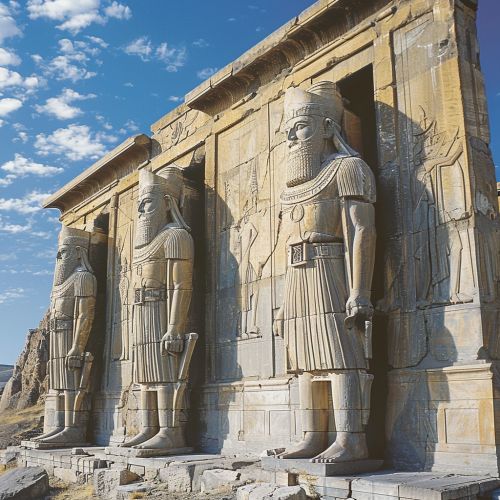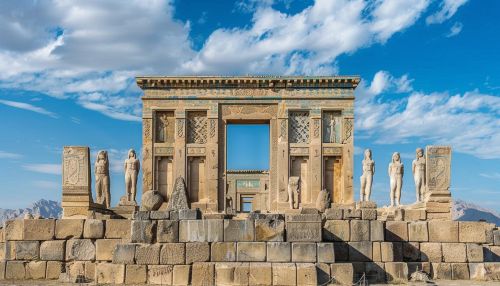Persia: Difference between revisions
(Created page with "== History of Persia == Persia, historically known as Iran, is one of the world's oldest continuous major civilizations, with historical and urban settlements dating back to 7000 BCE. The name "Persia" is derived from "Persis," the Greek name for the region of Parsa in the southwestern part of the country, which was the homeland of the Persians. The term was used by Western countries until 1935 when the Iranian government requested that the country be called...") |
No edit summary |
||
| Line 7: | Line 7: | ||
The history of ancient Persia is marked by the rise and fall of several powerful dynasties. The [[Achaemenid Empire]] (550–330 BCE) is often considered the first Persian Empire, founded by [[Cyrus the Great]]. This empire expanded to become one of the largest empires in history, encompassing parts of the Balkans, Eastern Europe, North Africa, and Central Asia. The Achaemenid Empire is known for its significant cultural, political, and military achievements, including the development of an efficient administrative system and the construction of the [[Royal Road]]. | The history of ancient Persia is marked by the rise and fall of several powerful dynasties. The [[Achaemenid Empire]] (550–330 BCE) is often considered the first Persian Empire, founded by [[Cyrus the Great]]. This empire expanded to become one of the largest empires in history, encompassing parts of the Balkans, Eastern Europe, North Africa, and Central Asia. The Achaemenid Empire is known for its significant cultural, political, and military achievements, including the development of an efficient administrative system and the construction of the [[Royal Road]]. | ||
[[Image:Detail-91539.jpg|thumb|center|Ruins of Persepolis, the ceremonial capital of the Achaemenid Empire.|class=only_on_mobile]] | |||
[[Image:Detail-91540.jpg|thumb|center|Ruins of Persepolis, the ceremonial capital of the Achaemenid Empire.|class=only_on_desktop]] | |||
The [[Seleucid Empire]] (312–63 BCE) followed the Achaemenid Empire after the conquests of [[Alexander the Great]]. The Seleucids maintained Greek culture and influence in the region, which led to a blend of Greek and Persian traditions. | The [[Seleucid Empire]] (312–63 BCE) followed the Achaemenid Empire after the conquests of [[Alexander the Great]]. The Seleucids maintained Greek culture and influence in the region, which led to a blend of Greek and Persian traditions. | ||
Latest revision as of 19:21, 20 June 2024
History of Persia
Persia, historically known as Iran, is one of the world's oldest continuous major civilizations, with historical and urban settlements dating back to 7000 BCE. The name "Persia" is derived from "Persis," the Greek name for the region of Parsa in the southwestern part of the country, which was the homeland of the Persians. The term was used by Western countries until 1935 when the Iranian government requested that the country be called "Iran" in international contexts.
Ancient Persia
The history of ancient Persia is marked by the rise and fall of several powerful dynasties. The Achaemenid Empire (550–330 BCE) is often considered the first Persian Empire, founded by Cyrus the Great. This empire expanded to become one of the largest empires in history, encompassing parts of the Balkans, Eastern Europe, North Africa, and Central Asia. The Achaemenid Empire is known for its significant cultural, political, and military achievements, including the development of an efficient administrative system and the construction of the Royal Road.


The Seleucid Empire (312–63 BCE) followed the Achaemenid Empire after the conquests of Alexander the Great. The Seleucids maintained Greek culture and influence in the region, which led to a blend of Greek and Persian traditions.
The Parthian Empire (247 BCE–224 CE) succeeded the Seleucids and is known for its conflicts with the Roman Empire. The Parthians were skilled horsemen and archers, and their military tactics were instrumental in their resistance against Roman expansion.
The Sassanian Empire (224–651 CE) was the last pre-Islamic Persian Empire, known for its cultural renaissance and significant contributions to art, science, and architecture. The Sassanians established a centralized government and promoted Zoroastrianism as the state religion.
Medieval Persia
Following the Islamic conquest of Persia in the 7th century, the region became a part of the Islamic Caliphate. The Abbasid Caliphate (750–1258) saw the flourishing of Persian culture and science, with notable contributions in fields such as medicine, astronomy, and literature. The House of Wisdom in Baghdad became a center for the translation of Greek and Persian texts into Arabic.
The Safavid Empire (1501–1736) marked the beginning of modern Persian history. The Safavids established Twelver Shia Islam as the state religion, which has had a lasting impact on Iranian identity. The empire is also known for its architectural achievements, including the construction of the city of Isfahan.
Modern Persia
In the 19th and early 20th centuries, Persia faced significant political and social changes. The Qajar Dynasty (1789–1925) struggled with internal strife and foreign intervention, particularly from Russia and Britain. The discovery of oil in the early 20th century added to the geopolitical significance of Persia.
The Pahlavi Dynasty (1925–1979) sought to modernize and secularize the country. Under the rule of Reza Shah Pahlavi and his son Mohammad Reza Pahlavi, Iran underwent significant industrialization and social reforms. However, political repression and economic disparities led to widespread discontent, culminating in the Iranian Revolution of 1979.
Culture and Society
Persian culture is rich and diverse, with influences from various civilizations that have interacted with the region over millennia. The Persian language, Farsi, is one of the oldest languages still in use today and has a rich literary tradition.
Literature
Persian literature is renowned for its poetry, with notable poets such as Rumi, Hafez, and Ferdowsi. The Shahnameh, written by Ferdowsi, is an epic poem that chronicles the history of Persia from its mythical origins to the Islamic conquest.
Art and Architecture
Persian art and architecture are characterized by intricate designs, vibrant colors, and elaborate tile work. The Persepolis ruins, the Naqsh-e Jahan Square in Isfahan, and the Golestan Palace in Tehran are prime examples of Persian architectural brilliance.
Religion
Zoroastrianism, one of the world's oldest monotheistic religions, originated in Persia. The religion was the state religion during the Achaemenid and Sassanian empires. Today, the majority of Iranians practice Shia Islam, which has played a significant role in shaping the country's cultural and political landscape.
Economy
The economy of Persia has historically been based on agriculture, trade, and later, oil production. The Silk Road facilitated trade between Persia and other major civilizations, contributing to the region's wealth and cultural exchange.
Agriculture
Agriculture has been a cornerstone of the Persian economy for millennia. The region's diverse climate allows for the cultivation of various crops, including wheat, barley, and rice. Persian gardens, known as Paradise Gardens, are famous for their design and irrigation techniques.
Trade
Persia's strategic location made it a hub for trade routes connecting the East and West. The Silk Road was a significant trade route that passed through Persia, facilitating the exchange of goods, ideas, and culture.
Oil Industry
The discovery of oil in the early 20th century transformed Persia's economy. The Anglo-Persian Oil Company, established in 1908, marked the beginning of the modern oil industry in Iran. Today, Iran is one of the world's largest producers of oil and natural gas.
